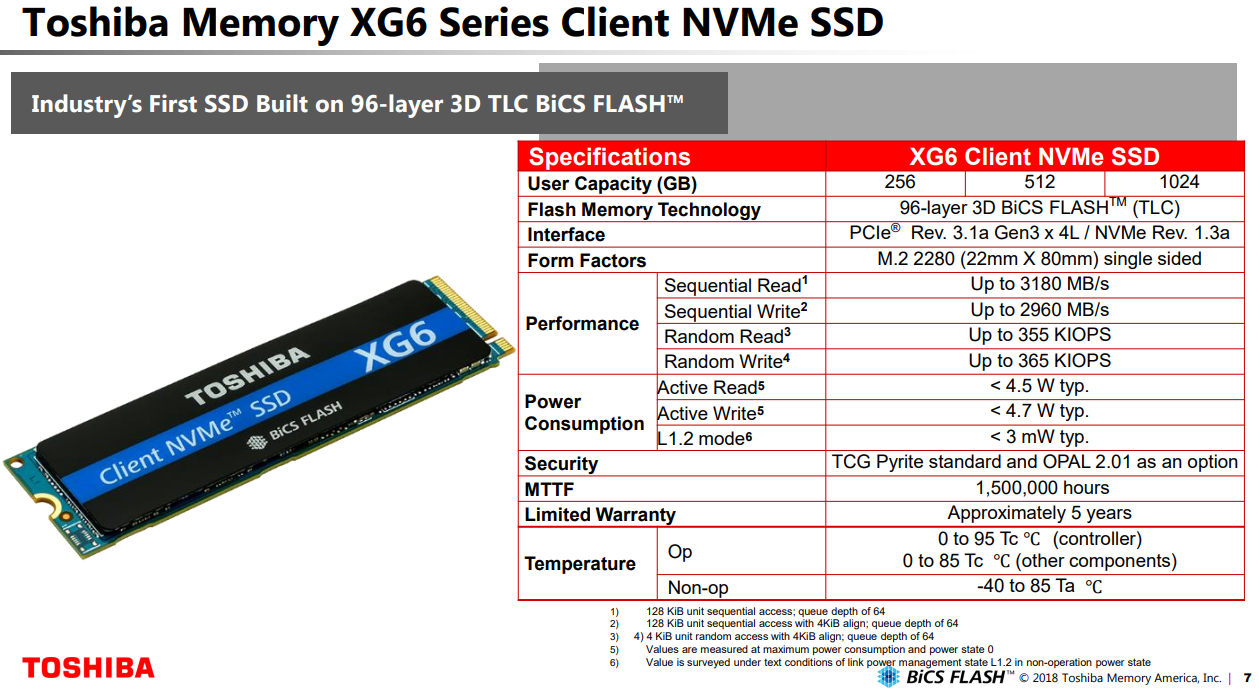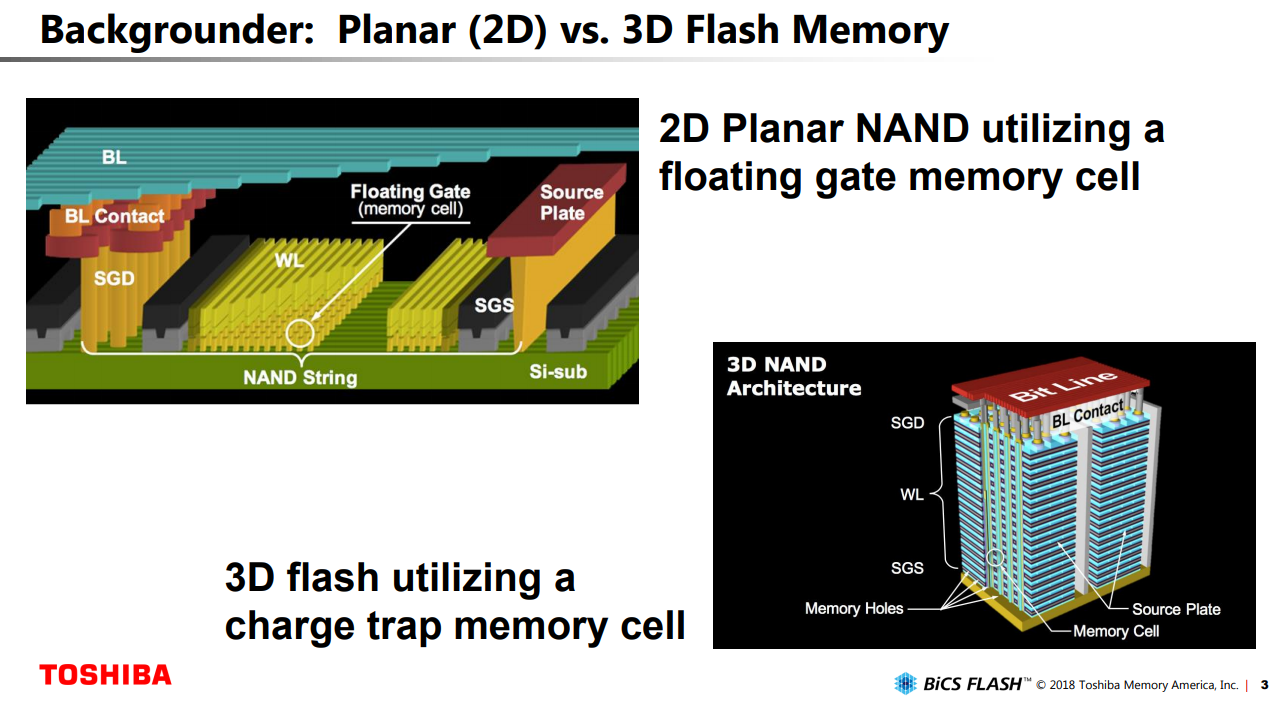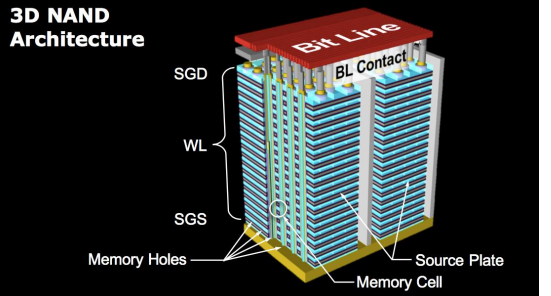Toshiba's New XG6 SSD Marks the Debut of its 96-Layer TLC Flash
Toshiba announced that its XG6 SSD, the first drive with 96-layer flash, is sampling to OEMs. The new SSD comes with Toshiba's new 96-layer 3D TLC BiCS flash, which comes with a 40% increase in density compared to Toshiba's previous-gen 64-layer BiCS3 flash.



The XG6 SSD marks a big step forward for Toshiba's client SSDs. The M.2 SSD uses the same NVMe controller that Toshiba used with the XG5, but firmware and flash improvements, along with an update to the NVMe 1.3a spec, have yielded tremendous improvements.
| Row 0 - Cell 0 | Sequential Read/Write | Random Read/Write IOPS |
| Toshiba 1TB XG5 | 3,000 / 2,100 MB/s | 152,129 / 125,553 |
| Toshiba 1TB XG6 | 3,180 / 2,960 | 355,000 / 365,000 |
Toshiba claims the XG6 reaches up to 3,180/2,960 MB/s of sequential read/write throughput and up to 355,000/365,000 random read/write IOPS over a PCIe 3.0 x4 connection.
Toshiba didn't release an official random read/write IOPS measurement for its previous-gen XG5 series, but we included our own measurements from the BiCS FLASH Preview With Toshiba XG5 NVMe SSD review in the table above. Toshiba more than doubled random read/write performance and also improved sequential write performance. Toshiba's XG6 uses an SLC buffer, so these numbers represent the best-case performance scenario.
Toshiba's XG6 tops out at 1TB in a single-sided M.2 form factor, which matches the previous-gen models. The company also plans to refresh its higher-capacity XG5-P series with the new 96-layer flash, which will bring maximum capacities up to 2TB.
Toshiba isn't sharing endurance information yet, but the XG6 is destined for mainstream read-intensive environments, like desktop PCs and OEM laptops, so it's safe to assume it isn't earth-shattering. The drives carry a five-year warranty. Toshiba hasn't shared pricing information, either. The drive is currently sampling to OEM customers and should come to the broader market in the coming months.
Toshiba's new BiCS4 flash, which it produces jointly with WD, is the real story. The new flash contends with new 96-layer flash from Samsung and 96-layer flash from partners Intel and Micron. Samsung is the only vendor to have a single 96-layer die, which the company accomplished by reducing the height of the layers by 20%.
Get Tom's Hardware's best news and in-depth reviews, straight to your inbox.


In contrast, Toshiba/WD is "String Stacking" two 48-layer die, which essentially means the company combines two separate 48-layer die into one final product with a density of 512Gbit. That adds extra steps to the manufacturing process, which might ultimately have an impact on yields, and thus pricing. Intel and Micron are also rumored to be taking the same string stacking approach with their next-gen NAND, but they haven't shared specifics. Time will tell which approach is more economical, as both approaches have advantages and disadvantages.
Toshiba's new flash comes with the Toggle 3.0 interface, which is the communication protocol that the NAND uses to communicate with the SSD controller. Toggle 3.0 communicates at 667-800 MB/s with a 1.2V I/O, while Samsung is using a faster Toggle 4.0 interface that communicates at 1.4 Gb/s yet also features a 1.2V I/O rating.
Toshiba/WD have also recently announced new QLC flash using the same 96-layer BiCS design, so the leading-edge 96-layer TLC SSDs will be followed by more capacious models in due course. We expect to learn more about the newest TLC and QLC flash at the Flash Memory Summit next month.

Paul Alcorn is the Editor-in-Chief for Tom's Hardware US. He also writes news and reviews on CPUs, storage, and enterprise hardware.
-
stdragon Reply21168944 said:You gotta start wondering what kind of heat these things generate.
Exactly my thought as well. Unless there's adequate cooling via a heatsink, I'd imagine this would thermal throttle after several seconds of sustained writes. Perhaps those numbers are for burst-able conditions, thus giving enough time for cool down?
